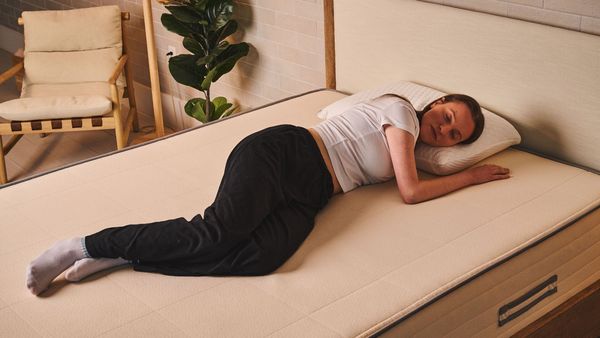
The average mattress is just six years old when it gets chucked out, according to the National Bed Federation. That’s an awful lot of foam and springs going to landfill. Should you stick with an uncomfortable bed for the sake of the planet, or choose more wisely next time you go mattress shopping?
We recommend the latter strategy, especially if you find a retailer who’ll recycle the old one for you. A well-made mattress that has the right balance of support and comfort for your size and sleeping position can genuinely transform the quality of your sleep. It can also soothe aches and pains, help you sleep in peace next to a partner – and should last much longer than six years.
But good, durable mattresses aren’t cheap. Some of the premium models I’ve tested for the Filter cost more than £1,000 for a double.
Today’s mattresses cover a boggling range of types, including “bed-in-a-box” options that are delivered directly from the factory. You can’t try out these mattresses before you buy, but they come with long trial periods so you can sleep on them for months before deciding whether to keep them. That’s arguably a better way to judge a mattress than being the 200th person to bounce on a showroom display bed.
Here we’ll run through the pros and cons of different types and reveal what to look for when you shop for your ideal mattress match.
***
Mattress types explained
***
Pocket sprung mattresses
Pros: supportive in the right places; more environmentally friendly than foam.
Cons: can be too bouncy if you share with a partner; may sag in time.
You can buy cheap “open coil” sprung mattresses that contain one long looped wire, but if you plan to sleep in any kind of comfort you should go for pocket sprung instead. These mattresses contain hundreds or even thousands of sturdy springs, each sewn into a fabric pocket to isolate any movement. This creates a robust but pleasingly bouncy foundation that supports and cushions you where needed. The isolation of each spring also helps absorb the movements of a partner, although not as well as foam.
Pocket sprung mattresses are said to have less environmental impact than foam or hybrid since their manufacture normally uses less plastic and they contain more natural fibres. This also allows the air to circulate and helps to stop you from overheating as you sleep.
Best value pocket sprung mattress
Ikea Valevåg
***
Memory foam mattresses
Pros: balance of comfort and orthopaedic support; isolates movement brilliantly.
Cons: can trap heat and feel clammy; takes some getting used to.
Some mattress foam is plain old polyfoam, the kind used for chair seats and as a comfort layer on top of the springs in pocket sprung mattresses. Memory foam is more expensive and much denser than polyfoam, so it offers excellent support – very firm, in some cases – as well as cushioning and pressure relief. It also does a fine job of absorbing movement.
Memory foam’s ability to mould to your body can make it feel marshmallowy and airless. Some people love this sensation but others do not, and it can lead to issues with overheating. Another option is latex foam, which is naturally breathable and hypoallergenic but costs more than standard memory foam.
Many all-foam mattresses contain layers of different kinds of foam, including polyfoam, latex and various densities of memory foam. Most claim to offer medium-firm support, but one thing I’ve learned from years of testing mattresses is that “medium firm” can mean anything from squishy to board stiff. The only way to be sure you get on with a foam mattress is to sleep on it for a while. Helpfully, many memory foam mattress manufacturers give lengthy trials.
Best memory foam mattress with a 365-day trial
Nectar memory foam mattress
***
Hybrid mattresses
Pros: best balance of cushioning, support, breathability and motion isolation.
Cons: can get very expensive and heavy; wide variations make it hard to choose your ideal match.
Cross a pocket sprung mattress with a memory foam mattress and you get a hybrid. Exactly how the foam, springs and other components fit together differs from mattress to mattress, with some premium models wrapping thousands of extra-tall springs in layers of latex foam, high-density memory foam, grid-shaped foam, bamboo-infused cooling foam and natural wool. Many also add a layer or two of “microsprings” that nudge up the comfort level by allowing them to contour to your body.
The idea of a hybrid is to have all the pros of springs and foam with none of the cons. There’s no such thing as the perfect mattress, however – only the perfect mattress for you, so hybrids inevitably vary in their firmness, cushioning, temperature control and motion isolation.
I’ve been reviewing the best and best-value hybrid mattresses for the Filter, and they’ve offered a surprising variety of pros and cons, with different models clearly excelling in different areas. My overall favourite is the Otty original hybrid. It’s firm but incredibly comfortable, with great motion isolation and breathability – and it’s more affordable than a couple of its rivals.
Best hybrid mattress
Otty Original Hybrid
***
Why firmer isn’t always better
One person’s perfect mattress is another’s back ache. (Commiserations if you’re one and your sleeping partner is the other.) One of the reasons I’m so in favour of buying a mattress with a long trial period is that it can take a few nights or even weeks to judge how well a mattress’s level of firmness suits you.
There are a couple of ways to predict how well you’ll get on with a new mattress, though. First, lie on your back and try to slide your hand under your lower back. If there’s plenty of room, the surface is too hard. If there’s no room at all, it’s too soft.
Now lie on your side in a sleeping position and ask someone to take a photo. If you can draw a straight-ish line along your spine and to your knees, then your spine is able to “align” and the mattress is a good match for you. If the line curves up or down, your spine can’t lie straight and you’ll be uncomfortable.
The ideal firmness of your mattress differs according to your natural sleeping position. If you sleep mostly on your side, you need extra cushioning for your hips, knees and shoulders (pressure points). A very firm mattress won’t work for you, especially if you have muscle or joint issues such as hip pain. If you sleep on your back or front, you can get away with a firmer surface.
No one will benefit from a mattress that’s too firm or too soft, though. “If it’s too soft, you’ll find it almost impossible to maintain a good posture when you’re asleep,” says Simon Durrant, director of the Sleep Research Centre at the University of Lincoln. “But if the mattress is too hard, it will lead to awkward sleeping positions and soreness, and as a result, you’ll wake up more often.”
Your size comes into it, too. Petite bodies don’t sink into cushioning as readily as larger ones do. If you’re small, you need a bit more softness to get comfy; if you’re big, you need a firmer surface to make you feel supported. Jack Sprat and his wife would certainly struggle when mattress shopping.
However big or small you are, don’t skimp on bed size. The Sleep Charity says bigger is better, and I tend to agree, subject to the size of your budget and living space. If you can stretch out in bed, you’ll sleep better and run less risk of stiffness or joint pain – and if you sleep next to someone, you’ll both welcome the extra room.
***
Mattress features worth paying for (and some that aren’t)
Size, firmness and price are probably the main factors you’ll have in mind when you choose a mattress, but there are other things to consider.
A warranty of 10 years or more is a good sign that a mattress is built to last. The minimum I’d advise spending on a double is about £500, unless it’s for the kids or a spare room. Most warranties will guarantee that the mattress won’t sag significantly or have broken springs and burst seams within a decade – just don’t jump on it, as this will void the warranty.
All bed-in-a-box mattresses come with a trial period during which you can send the mattress back, no questions asked, as long as you’ve taken care of it by using a mattress protector. Trials range from 100 days (Panda) to 365 nights (Ikea and Nectar); most are 200 nights (Simba, Eve, Origin).
A washable removable cover is a must-have if the mattress contains memory foam, which can trap heat. Most good hybrid and foam mattresses have soft fabric covers that you can unzip and throw in the washing machine at 40C.
Another useful extra is a cooling layer, which helps counteract the balmy effect of foam. No mattress can actively reduce your body temperature – it’s not like putting your sheets in the fridge – but layers that contain breathable materials such as wool, bamboo and graphite can prevent overheating and help you sleep in comfort, especially if you’re struggling with the sweaty effects of menopause or medication.
One feature I’m less sold on is zoned support. A zoned mattress offers different levels of tension in different areas to correspond with the bits of your body that need support and cushioning. The trouble is, we’re all different shapes and sizes. Unless you’re bang on average and stay very still while you sleep, the mattress’s zones are unlikely to correspond perfectly with yours.
Then there are double-sided mattresses that come with a choice of firmness. I’ve tested only one of these so far, the Eve Wunderflip Hybrid, and I found the two sides to be similarly soft. Switching between them wasn’t just a matter of flipping the mattress over, either; you had to detach and reattach a heavy foamy comfort layer. And what if you and your partner disagree on which side to use? Better to pick a mattress that suits you both.
If you can’t agree on firmness and are determined to share a mattress, there are dual tension mattresses, made up of two halves, each with a different firmness level. Dormeo’s Dual Core mattresses are a good example. They attach using a zip, so it’s more comfortable and secure than pushing beds together in a twin hotel room.
Most mattress brands offer to collect and recycle your old mattress when delivering the new one, but I’m torn on whether this is worth paying for. You’re often charged £40 or more, and in my experience, the mattress delivery guys aren’t always forewarned that they’re collecting. Your local council may be able to recycle your mattress more cheaply and efficiently.
***
Will a new mattress help you sleep better?
A mattress has one job, more or less: to help you sleep in comfort. “A good mattress can’t guarantee a good night’s sleep, but a bad mattress will often lead to a poor night’s sleep,” says the Sleep Research Centre’s Durrant. You can certainly improve your chances of sleeping well by choosing well.
The relationship between good sleep and your choice of mattress gets more pertinent as you get older. “Younger people are more robust to the effects of a less-than-ideal mattress,” says Durrant. “As we get older, we take longer to get to sleep and wake up more, which makes us more aware of our mattress and its comfort. Also, as we age we’re more prone to feeling stiff and sore after a few hours in bed, so we’re more dependent on a good-quality mattress.”
It can be hard to know whether a mattress is perfect for you after one night, let alone five minutes in a showroom. Also bear in mind that a new mattress can feel weird at first, especially if you’ve switched to hybrid or foam after years on a sprung mattress. But if you’re still struggling to get used to a mattress after a couple of weeks, don’t be shy about taking advantage of that free trial – and then another one, and another one – until you find your perfect match.










